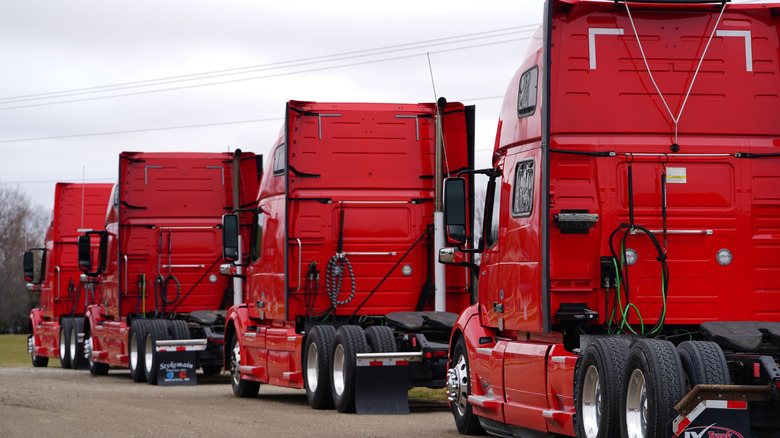Why Do The Front Rims On Semi-Trucks Stick Out?
There's no denying that semi-trucks are pretty common vehicles on today's roads. It is nearly impossible to find an urban area without one, a testament to not only how widespread they are, but to how impactful and valuable they are. Semis can be adapted to several activities, from hauling cargo like consumer goods across countries, to towing heavy equipment like cranes from different sites.
However, despite their commonality, these vehicles have several features that perplex even the most dedicated vehicle enthusiasts. You might wonder why many semi-trucks come with spikes on their wheels, or why their front wheels typically stick out.
As for the second question, it has everything to do with stability and load-bearing capacity. The tire's hub is bulged to allow enough room for brake systems, bearings, bushings, and the steering joints. The shape also allows for a wide axle to be installed, which improves the truck's stability. Let's delve into this feature to understand why it is necessary in a semi-truck's overall design.
Yes, semi-trucks are more than 120 years old
While the first diesel truck was built back in the 1920s, semi-trucks have a history that reaches into the late 1800s. Of course, what existed then can only dream of living up to the 18-wheel behemoths we have today. Generally, a semi-truck usually comes with three axles, one for the front wheels and two for the rear ones. While the rear wheels feature concave faces, the front ones are primarily convex, or bulging out.
Like many machines today, cars are made up of several parts that make up systems that work together to make the car move, turn, or stop, and this includes making the tires to work as expected. These include, but are not limited to, the tire itself, the suspension, and the steering systems.
To adapt the semi-truck for the heavy-duty tasks it typically undertakes, the systems surrounding the wheel and its performance are optimized accordingly, with many of them utilizing the space created by the bulge in the front tires.
It's all about steering, braking, and stability
The first of these is the steering system. As stated, the bearings, bushings, and steering joints are located within the bulged hub. The bearings and bushings reduce the friction between the moving parts, while the steering joints connect to the steering column, which, in turn, connects to the steering wheel.
The suspension system is also found within the space provided by the bulge, with enough room for items such as the semi's front brakes. Furthermore, the front wheels stick outward to accommodate the widest possible front axles, enhancing the truck's overall stability.
Considering the many semi-truck brands available today and the sheer number of these vehicles navigating city streets and rural roads, you're likely to see one pass by with convex front tires. While there may be more exciting features of the semi-truck to discuss for the next half hour with your family, friends, or acquaintances, such as the engines and the truck's towing capacity, mentioning the shape of the front wheels might not be a bad idea.


